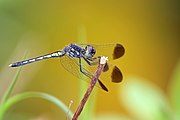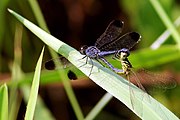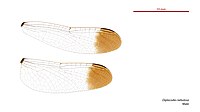Diplacodes nebulosa
Appearance
| Black-tipped percher | |
|---|---|

| |
| Male | |

| |
| Female | |
| Scientific classification | |
| Domain: | Eukaryota |
| Kingdom: | Animalia |
| Phylum: | Arthropoda |
| Class: | Insecta |
| Order: | Odonata |
| Infraorder: | Anisoptera |
| Family: | Libellulidae |
| Genus: | Diplacodes |
| Species: | D. nebulosa
|
| Binomial name | |
| Diplacodes nebulosa | |

| |
| Synonyms | |
|
Libellula nebulosa Fabricius, 1793 | |
Diplacodes nebulosa (the black-tipped percher,[1] black-tipped ground skimmer[3][4] or charcoal-winged percher[5]) is a species of dragonfly in the family Libellulidae. It is a widely distributed species in many Asian countries.[1][6][3][4] and northern Australia.[7][8]
Description and habitat
[edit]Diplacodes nebulosa is a very small and slender dragonfly.[5] Males have a black abdomen and black wing tips; females are yellow and black, and their wings can be hyaline, or with an orange base, or, like the male, have black tips.[9]
Gallery
[edit]-
Male
-
Female
-
Sub-adult male
-
Mating pair
-
Male, north Queensland, Australia
-
Female wings
-
Male wings
It prefers marshes and heavily weeded ponds.[10][11]
See also
[edit]References
[edit]- ^ a b c Dow, R.A.; Sharma, G. (2017). "Diplacodes nebulosa". IUCN Red List of Threatened Species. 2017: e.T167369A87526935. doi:10.2305/IUCN.UK.2017-1.RLTS.T167369A87526935.en. Retrieved 20 November 2021.
- ^ Fabricius, Johann Christian (1793). Entomologia Systematica Emendata et Aucta. Secundum, Classes, Ordines, Genera, Species, adjectis synonimis, locis, observationibus, descriptionibus (in Latin). Hafniae : impensis Christ. Gottl. Proft. p. 379 – via Google Books.
- ^ a b "Diplacodes nebulosa Fabricius, 1793". India Biodiversity Portal. Retrieved 2017-02-13.
- ^ a b "Diplacodes nebulosa Fabricius, 1793". Odonata of India, v. 1.00. Indian Foundation for Butterflies. Retrieved 2017-02-13.
- ^ a b Theischinger, Günther; Hawking, John (2006). The Complete Field Guide to Dragonflies of Australia. Collingwood, Victoria, Australia: CSIRO Publishing. p. 278. ISBN 978-0-64309-073-6.
- ^ Odonata: Catalogue of the Odonata of the World. Tol J. van , 2008-08-01
- ^ Theischinger, Gunther; Endersby, Ian (2009). Identification Guide to the Australian Odonata (PDF). Department of Environment, Climate Change and Water NSW. p. 211. ISBN 978-1-74232-475-3.
- ^ K.A., Subramanian; K.G., Emiliyamma; R., Babu; C., Radhakrishnan; S.S., Talmale (2018). Atlas of Odonata (Insecta) of the Western Ghats, India. Zoological Survey of India. pp. 320–321. ISBN 9788181714954.
- ^ Watson, J.A.L.; Theischinger, G.; Abbey, H.M. (1991). The Australian Dragonflies: A Guide to the Identification, Distributions and Habitats of Australian Odonata. Melbourne: CSIRO. ISBN 0643051368.
- ^ C FC Lt. Fraser (1936). The Fauna of British India, including Ceylon and Burma, Odonata Vol. III. Red Lion Court, Fleet Street, London: Taylor and Francis. pp. 335–336.
- ^ C FC Lt. Fraser (1924). A Survey of the Odonate (Dragonfly) Fauna of Western India and Descriptions of Thirty New Species (PDF). p. 434.
Wikimedia Commons has media related to Diplacodes nebulosa.
Wikispecies has information related to Diplacodes nebulosa.








